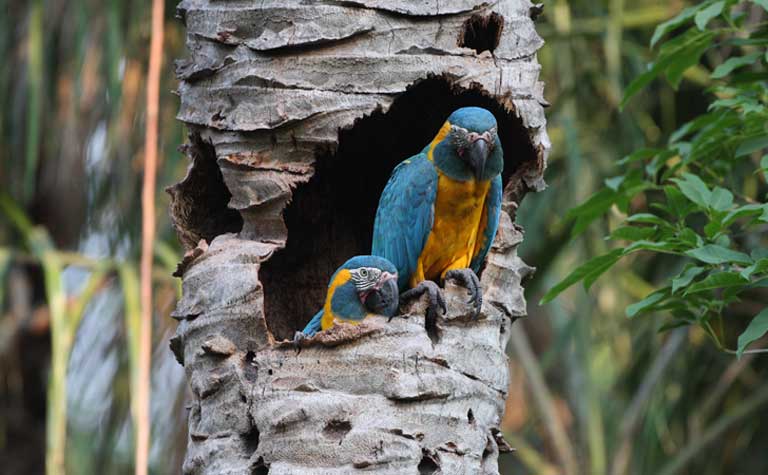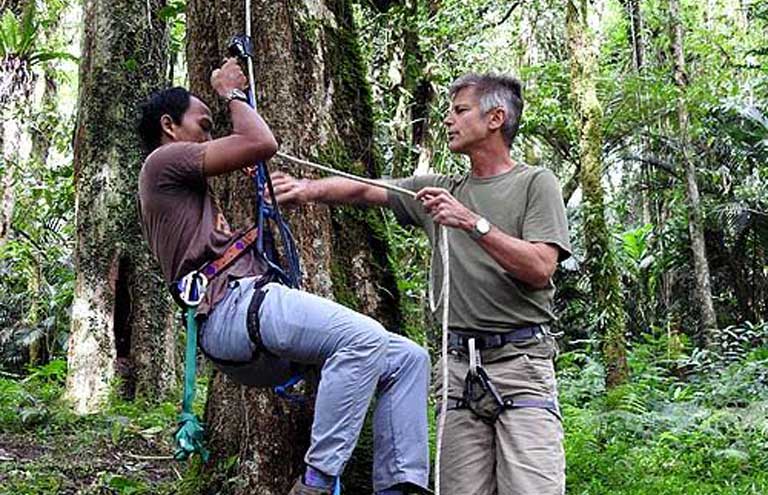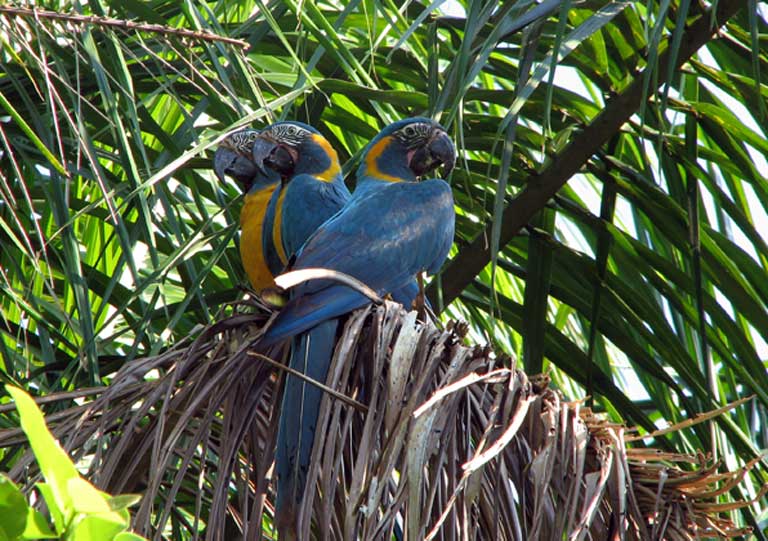- Bolivia is home to 12 species of macaws, and most are thriving. Not among these healthy parrot populations, however, is the Critically Endangered Blue-throated macaw (Ara glaucogularis), with less than 15 breeding pairs known to be nesting in a remote, widely dispersed range in the north of the country.
- Years of intensive effort using traditional conservation methods to protect wild Blue-throated macaws from predators, raise chick survival rates, and engage local human communities have not significantly boosted the wild population nor have new breeding pairs been discovered.
- Rethinking a long-held view that captive-bred parrots released to the wild have little hope of surviving there, James Gilardi is working with local and international partners to select and prepare captive, pet trade and confiscated macaws to join their wild counterparts.
- Although there haven’t been any releases of captive Blue-throated macaws as yet, Gilardi is confident that wild populations of the species can recover if the captive birds are carefully chosen, health screened, and fully prepared for the wild.

After relentless trapping for the pet trade reduced wild Blue-throated macaw populations to mere rumors, the bird was rediscovered in 1992 in a remote area of Bolivia. Endemic only to this nation, Ara glaucogularis lives in hard-to-reach places that are flooded much of the year. Unable to easily survey similar locales, conservationists could only hope that more of the Critically Endangered parrots existed than the hundred or so they originally found.
An intensive regimen to protect the remaining birds was put into action by local NGOs —including the Conservación de Loros de Bolivia, and the Research Center for Biodiversity and the Environment — along with academic collaborators and the World Parrot Trust.
However, more than a decade of hands-on conservation yielded frustrating results, with no significant population increase or recruitment of new breeding pairs.
At that point the World Parrot Trust, under the guidance of executive director Jamie Gilardi, began to consider the captive population they had been managing for more than 15 years in a different light. Under the right conditions, perhaps some of these birds could be readied for release to the wild. If captive-reared bird releases were successful, then parrots rescued from the illegal trade might also help create a bit of bird “restitution.”

Now Gilardi and his colleagues hope to add more breeding pairs back into Bolivia’s Beni Department, in the northeast corner of the country, by carefully selecting healthy birds in captivity that have retained enough wild ways to be returned to the un-caged life.
“In the past, the thinking was that the only real way to achieve honest-to-goodness conservation was to protect wild birds where they are, and then hope they can recover with human assistance or on their own,” says Gilardi.
But the Blue-throated macaw is in too precarious a position not to explore every possible option to rebuild its population. With likely less than 300 birds scattered across a vast and inhospitable terrain, waiting for nature to take its course might allow the species to slip into extinction. Researchers hope to release a first test group of captive Blue-throated macaws as soon as possible.


Mongabay: What made you look beyond the usual approaches to protecting wild populations?
Gilardi: When we started out, about 16 years ago, it seemed to us — as had been the case for so many other parrot conservation efforts — that if we just left the birds alone and protected them from people and other predators, then they’d bounce back pretty quickly. Maybe not as fast as rabbits or sea turtles, but certainly over the course of years, we expected the population to stabilize and then start growing.
But with the Blue-throated macaws, we were working with such a small group, and every year some new thing became a big problem [threatening the species with extinction]. One year it was other parrots harassing the nesting pairs. Another year it was predation from small mammals. By the time we got to year ten, we realized there still weren’t that many birds and new recruits weren’t joining the breeding population.
So we slowly came around to the idea that we had to switch our approach because these birds are not only very small in number, they are also spread broadly across the landscape, making it even harder for them to form breeding pairs. These and other factors were apparently preventing the expected recovery.
At that point, [we saw] the captive population we’d been managing for 15 plus years as something that might be essential to the species recovery. So even though our top priority is protecting the wild birds and supporting breeding pairs to help them produce as many chicks as possible every year, we’re also focused on getting captive birds back to Bolivia, breeding them, and releasing those progeny back to selected areas of the wild.

Mongabay: When will you start releasing the birds?
Gilardi: As soon as possible.
One thing about eradicating a species from its former range, is there’s a lot of room for them to return. But lots of things have to be sorted out before any releases happen.
Initially we would want to create a “proof of concept” release site where we build up the number of birds at a site that’s working for them; a place where they’re finding each other, breeding, and raising chicks.
Once we do that, we can start augmenting the existing groups of birds out there, putting two nests here, three over there… until hopefully we’d create a situation where there’s enough population density that the birds can find each other. We’d like all these birds to be in contact with each other, exchanging genes and see the whole population growing. If we got to that point, we’d be well on our way to success.
But first, we need to get the [captive] birds back to Bolivia. Although some birds are in the country, many [confiscated and pet trade birds] are elsewhere: about 50 Blue-throated macaws are in Florida, 30 are in Canada, maybe two dozen are in England, and another two dozen are in the Middle East.

The birds need to be biologically ready to go, too. Besides getting acclimated to a new place, screened for diseases, and oriented to wild foods, the macaws need to be in good physical condition to fly. Most people don’t realize how a bird’s physical condition plummets in captivity. A wild parrot can fly 40 to 50 kilometers [about 25 to 31 miles] without stopping, but a bird that’s been caged, even for just a few months, would have a hard time flying even one kilometer. It takes time to get the birds to develop that condition, so when they do go out they can fly with confidence, land appropriately, and aren’t completely exhausted by flying 100 meters.
Mongabay: What made you consider returning confiscated and pet trade birds back to the wild?
Gilardi: Up until about ten years ago, the dogma was that parrots are really hard to release back into the wild, and if you do they’re never going to eat properly and survive.
However, apart from the work we do with Critically Endangered species like the Blue-throated macaw, we also work really hard to stop the wild bird trade. One result of enforcement is that large groups of birds get confiscated and many of those birds are common species.
Over time, we learned how to prepare these birds for release [back into the wild]. We tracked them and found they were doing well, so we realized it’s not that hard to do, so long as you get the details right. For example, we’ve successfully reintroduced African grey parrots in Uganda, and Scarlet and Great-green Macaws in Central America.

Recently, the Ara Project in Costa Rica discovered that Great-green macaws (Ara ambiguus) released over the past few years currently have at least eight active nests. That’s more than 25 percent of the total number of nests for the species in the entire country.
In the case of the Blue-throated macaw, we’re eager to apply this reintegration method that we’ve developed as a result of our work on stopping the wild bird trade. Now we feel very comfortable releasing birds that were kept in captivity, whether they were confiscated or captive bred. That’s why we’re confident that releasing Blue-throated macaws can be a very productive way to get more birds back into the wild so their population recovery can take place.
We kind of got here sideways; it wasn’t intentional, but we ended up developing a lot of confidence in this new tool. For us, it’s really exciting because it opens up a ton of possibilities, not only for getting the job done, but also for allowing all kinds of partnerships — with the London Zoo, Africa Lion Safari in Canada, Natural Encounters Conservation Fund based in the U.S., and other NGO’s all around the world.
Compared to ten years ago, we view the whole conservation landscape differently [and more positively]. We never dreamed we’d be able to put lots of these birds back into the wild. Now we can.
For more on the topic:
Azul, Barba. Good news: Refuge for last Blue-throated macaws doubles in size in Bolivia. Mongabay, January 2, 2014
Berkunsky I, Daniele G, Kacoliris FP, Díaz-Luque JA, Silva Frias CP, Aramburu RM, et al. Reproductive Parameters in the Critically Endangered Blue-Throated Macaw: Limits to the Recovery of a Parrot under Intensive Management. PLoS ONE (2014) Volume 9 (6):
Eggleston, Emily. Illegally Captured parrots finally free to fly. Mongabay. August 19, 2013
Correction: In the original version of this story the third photo (same one behind the headline) mistakenly showed a pair of Blue-and-gold macaws, not Blue-throats. The error has been corrected.
FEEDBACK: Use this form to send a message to the author of this post. If you want to post a public comment, you can do that at the bottom of the page.














